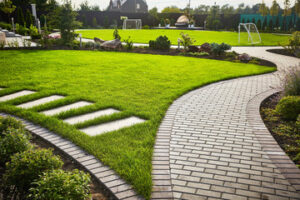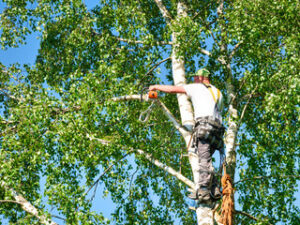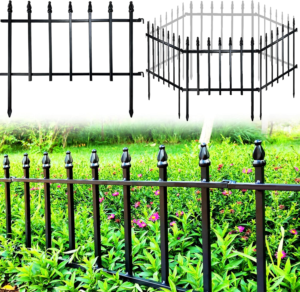Hardscapes are non-living elements of your landscape such as walkways, patios, retaining walls, brickwork, fire pits and water features. They are essential to a well-designed landscape and add value to your home.

A great landscaper will ensure that your hardscapes match the rest of the landscaping. They will use curves and rounded shapes to promote a fluid transition between your yard and the natural environment.
A well-designed hardscape makes your home’s exterior stand out from the rest, offering a unique look that’s both eye-catching and welcoming. As a form of landscaping, hardscapes include elements such as patios, pathways and even retaining walls. When these features are creatively combined, they can transform your yard into a stunning outdoor living space.
When incorporating hardscapes into your landscape, it’s important to keep in mind the overall aesthetic of your home and choose materials that complement the architecture. For example, if your home is modern, opting for pavers with clean lines and neutral colors will help create an elegant yet effortless look. Similarly, if your home is traditional, adding more variety and color to your plantings can add drama and visual interest.
Hardscapes are also an excellent way to enhance your property’s curb appeal. For example, a pergola or gazebo can provide shade, shelter and privacy and is the perfect home for climbing plants like ivy and roses. Additionally, a water feature can be a stunning focal point that draws attention to your yard.
However, it’s important to note that hardscapes should be carefully balanced with soft scapes such as grasses, shrubs and flowers. For example, a rock garden that features creeping plants between the stones can add visual interest and helps to prevent soil erosion. Additionally, choosing permeable pavers allows rainwater to seep into the ground instead of washing away your landscaping, reducing the risk of foundation issues.
Another benefit of hardscapes is that they can reduce the amount of maintenance required for your lawn. For instance, a paved patio is a great alternative to a traditional lawn that requires regular mowing, weeding and trimming. Additionally, a retaining wall can help prevent erosion and stabilize sloped areas of your yard, minimizing the risk of damage to your home.
In addition to reducing maintenance, hardscapes can also increase your home’s value and boost its curb appeal. When it comes time to sell, potential buyers will be more likely to take interest in your home if it has attractive landscaping. Moreover, if you decide to stay in your home for years to come, hardscaping can make it more enjoyable to spend time outdoors.
Adds Value to Your Home
A well-done hardscape project will add value to your home, especially if you decide to sell it in the future. Buyers will see that the property has been well cared for and may be willing to pay more than your asking price if the home has desirable features such as a patio or outdoor kitchen.
In addition to the aesthetic appeal that hardscapes provide, they also reduce overall maintenance costs for homeowners. For example, by adding concrete walkways instead of grass to your property, you can decrease the amount of water and other resources needed for maintenance. Other hardscape elements, such as retaining walls or a driveway made from pavers, can help with erosion control and minimize the risk of flooding or soil damage.
The right type of hardscape can enhance your outdoor living space and create a space for family and friends to gather. Patios and barbecue areas are great places to enjoy time with loved ones, and they can be enhanced with the addition of seating, lighting, or a fire table for added ambiance.
Hardscapes also create privacy and separate your property from neighbors’ homes. Retaining walls and other features like walkways can help keep your home private, especially if you live in a densely populated area.
With the changing climate, many cities are rethinking their approach to urban landscapes. With the new vision, it’s becoming apparent that green spaces are essential to a healthy and sustainable city. And hardscapes can be used to complement these initiatives by creating a beautiful and functional urban environment.
Hardscapes are the perfect way to add style and function to your outdoor living space. By utilizing different types of stone, gravel, or concrete, you can create a unique look that will blend seamlessly with your landscaping and compliment the surrounding architecture. From the rustic charm of natural stone to the modern look of concrete, there are many options available.
Increases Outdoor Living Space
A well-designed hardscape enhances the beauty of your garden and adds value to your property. It can also extend the outdoor living space of your home, giving you more options for entertaining and relaxing. Unlike traditional plants, hardscapes don’t die in the winter, so you can use them all year round. They also provide a natural alternative to sun glare, which can be damaging to your eyes and your furniture. By installing trellises, pergolas, and stone or brick walls, you can increase the amount of shade in your yard, protecting your family, friends, and pets from the sun’s harmful rays.
Another benefit of hardscaping is that it can help reduce the amount of time you spend on yard maintenance. While softscapes require regular watering, fertilizer, and weed removal, hardscapes reduce the need for this maintenance by providing a solid surface that is durable and easy to maintain. By using different materials in your hardscaping project, you can add unique textures to your garden and create focal points that draw the eye.
The versatility of hardscape allows you to create a space that aligns with your personal aesthetic and complements the architectural style of your home. From stone pathways to stylish outdoor kitchens and fire pits, hardscapes offer endless possibilities for creativity and customization. You can even incorporate water features into your hardscape, such as ponds and fountains, to create a soothing ambiance in your garden.
While some hardscapes have a more industrial look, such as concrete walkways and driveways, others have a more organic feel. You can achieve this by using repurposed materials, such as recycled pavers made from old roads, railway ties, or plastics; wood aggregates, like pebbles and sea glass; or concrete that has been stained, stamped, or etched. In addition to reducing the environmental impact of your landscape, using recycled or upcycled materials for your hardscapes can cut back on the need for fossil fuel-based equipment to maintain your garden and lawn, such as lawn mowers and leaf blowers.
By incorporating hardscape elements into your landscaping plan, you can create a functional and beautiful space for entertaining and relaxing in your backyard. By choosing a material, design, and size that suits your needs, you can create a hardscape that will meet both your budget and style preferences.
Reduces Maintenance
Hardscapes like patios, walkways, sitting walls, water features and retaining walls require much less maintenance than the softscape areas of your landscape. Unlike plants and lawns that need to be watered, weeded, fertilized, and trimmed on a regular basis, hardscapes are much more low-maintenance. However, they still need some care. Regular cleaning, stain removal and seasonal repairs are essential to preserving the look and structural integrity of your hardscapes.
Hardscape elements create a functional and appealing outdoor space that extends the usable square footage of your home. An expansive paver patio can be the focal point of your landscape design, or it can blend seamlessly with other hardscape and softscape elements to create a cohesive look.
In addition to the aesthetic and functional benefits, hardscapes can be an environmentally friendly choice. For example, incorporating permeable pavers allows rainwater to filter through and reduce runoff. Incorporating rain gardens and other green infrastructure can also help improve the quality of your waterways.
Today, many hardscape options are designed to be more sustainable than traditional concrete and asphalt. Tree grates, water-clearing trench drains, stormwater grates and detectable warning plates, and manhole covers are just a few of the innovative ways hardscapes are becoming more eco-friendly.
Whether you are looking for an attractive way to enhance your outdoor living spaces, or you are hoping to increase the resale value of your home, hardscapes are an excellent investment. With proper care, they can last for years and contribute to a more beautiful and livable environment for you and your family.
If you want to learn more about the benefits of adding hardscapes to your home, call one of our hardscape experts today! We can discuss your landscaping needs, explain the different hardscape options available, and help you design a hardscape that will suit your style and fit your budget.


